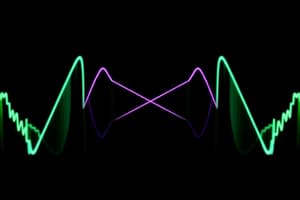Podcast
Questions and Answers
What is the general study of meaning in language?
What is the general study of meaning in language?
- Phonetics
- Pragmatics
- Syntax
- Semantics (correct)
Lexical semantics focuses on sentence meaning, not word meaning.
Lexical semantics focuses on sentence meaning, not word meaning.
False (B)
What does 'sense' and 'reference' relate to?
What does 'sense' and 'reference' relate to?
- Lexical semantics (correct)
- Pronunciation
- Syntactic structure
- Word order
The literal, dictionary definition of a word is its ______.
The literal, dictionary definition of a word is its ______.
What is the term for the emotional associations of a word?
What is the term for the emotional associations of a word?
Intension and extension are unrelated concepts in semantics.
Intension and extension are unrelated concepts in semantics.
Breaking down a word's meaning into smaller parts is called semantic ______.
Breaking down a word's meaning into smaller parts is called semantic ______.
What does the semiotic triangle explore?
What does the semiotic triangle explore?
A lexical field is a group of unrelated words.
A lexical field is a group of unrelated words.
What are semantic prototypes?
What are semantic prototypes?
Give an example of a constant referent.
Give an example of a constant referent.
Which of the following is an example of a lexical field?
Which of the following is an example of a lexical field?
The expressions 'The Mona Lisa', 'La Gioconda' and 'Leonardo da Vinci's most famous painting' all have the same sense but different referents.
The expressions 'The Mona Lisa', 'La Gioconda' and 'Leonardo da Vinci's most famous painting' all have the same sense but different referents.
What does the word 'rat' denote?
What does the word 'rat' denote?
According to the semiotic triangle, a word is a ______ sign.
According to the semiotic triangle, a word is a ______ sign.
Which is an example of a body of water within the lexical field of 'bodies of water'?
Which is an example of a body of water within the lexical field of 'bodies of water'?
According to semantic analysis, 'love and romance' is the denotation of 'a rose'.
According to semantic analysis, 'love and romance' is the denotation of 'a rose'.
According to semantic analysis, 'loyalty' is the ______ of 'a dog'.
According to semantic analysis, 'loyalty' is the ______ of 'a dog'.
Match the referents to its type:
Match the referents to its type:
According to prototype semantics, which of these is the most prototypically bird?
According to prototype semantics, which of these is the most prototypically bird?
Flashcards
Semantics
Semantics
The study of meaning in language, including words, phrases, and sentences.
Lexical semantics
Lexical semantics
The study of word meanings and relationships between them.
Reference
Reference
The actual object or entity in the world to which a word or expression refers.
Sense
Sense
Signup and view all the flashcards
Denotation
Denotation
Signup and view all the flashcards
Connotation
Connotation
Signup and view all the flashcards
Intension
Intension
Signup and view all the flashcards
Extension
Extension
Signup and view all the flashcards
Componential analysis
Componential analysis
Signup and view all the flashcards
The semiotic triangle
The semiotic triangle
Signup and view all the flashcards
Lexical field
Lexical field
Signup and view all the flashcards
Semantic prototype
Semantic prototype
Signup and view all the flashcards
Lexical fields
Lexical fields
Signup and view all the flashcards
A "rose"
A "rose"
Signup and view all the flashcards
Semantic componential analysis
Semantic componential analysis
Signup and view all the flashcards
Referents
Referents
Signup and view all the flashcards
Intension
Intension
Signup and view all the flashcards
Prototype
Prototype
Signup and view all the flashcards
Study Notes
- These study notes cover derivation of the Black-Scholes Formula, Matrices, Hypothesis Testing, Time-Dependent Perturbation Theory, Modeling the Spread of Disease, Coupled Oscillations, Dictionaries and Linear Algebra
9. Derivation of the Black-Scholes Formula
- Describes how to determine/understand the price of derivatives.
9.1 The Black-Scholes PDE
- $V(S, t)$ represents derivative price as a function of underlying asset price $S$ and time $t$.
- $\sigma$ represents the volatility of the underlying asset.
- $r$ represents the risk-free interest rate.
- The partial differential equation is: $\frac{\partial V}{\partial t} + \frac{1}{2} \sigma^2 S^2 \frac{\partial^2 V}{\partial S^2} + rS \frac{\partial V}{\partial S} - rV = 0$
Derivation Sketch
- Construct a risk-free portfolio with the derivative and underlying asset.
- Use Ito's Lemma to describe derivative price change.
- Apply the no-arbitrage principle: risk-free portfolio earns the risk-free rate.
9.2 The Black-Scholes Formula
- $C(S, t)$ is price of European call option with strike price $K$ and maturity $T$.
- The formula is: $C(S, t) = S N(d_1) - Ke^{-r(T-t)} N(d_2)$
- $d_1 = \frac{ln(S/K) + (r + \sigma^2/2)(T - t)}{\sigma \sqrt{T - t}}$
- $d_2 = \frac{ln(S/K) + (r - \sigma^2/2)(T - t)}{\sigma \sqrt{T - t}} = d_1 - \sigma \sqrt{T - t}$
- $N(x)$ is the cumulative distribution function of the standard normal distribution.
Matrices
- A matrix is a rectangular table of numbers commonly used in math, physics and computer science
- An $m \times n$ matrix is a table of numbers with $m$ rows and $n$ columns
- $a_{ij}$ is the element in the $i$-th row and $j$-th column.
Examples
- $A = \begin{bmatrix} 1 & 2 & 3 \ 4 & 5 & 6 \end{bmatrix}$ is a $2 \times 3$ matrix
- $B = \begin{bmatrix} 1 & 2 \ 3 & 4 \ 5 & 6 \end{bmatrix}$ is a $3 \times 2$ matrix
- $C = \begin{bmatrix} 1 & 2 & 3 \ 4 & 5 & 6 \ 7 & 8 & 9 \end{bmatrix}$ is a $3 \times 3$ matrix
Matrix Types
- Square Matrix: Same number of rows and columns
- Identity Matrix: Square matrix with 1s on the main diagonal and 0s everywhere else
- Transpose Matrix: Obtained by swapping rows and columns.
Matrix Operations
- Addition: Matrices can be added if they have the same dimensions.
- Subtraction: Matrices can be subtracted if they have the same dimensions.
- Multiplication: Matrices can be multiplied if the number of columns in the first matrix equals the number of rows in the second matrix.
- Scalar Multiplication: Multiply each element of the matrix by the scalar.
Matrix Applications
- Solving systems of linear equations.
- Linear transformations.
- Computer graphics.
- Probability and statistics.
Hypothesis Testing
- Hypothesis Testing involves five steps
- State the null hypothesis, $H_0$ and alternative hypothesis, $H_A$
- Choose $\alpha$, the significance level of the test which represents the probability of rejecting $H_0$ if true
- Compute the test statistic
- Determine the $p$-value
- Reach a conclusion, if the $p$-value is less than $\alpha$ reject the null hypothesis, and if the $p$-value is greater than $\alpha$ fail to reject the null hypothesis
One Sample t-Test
- An example is presented regarding measuring the average height of US women against 64 inches
- $H_0: \mu = 64; H_A: \mu \neq 64$
- $\alpha = 0.05$
- The test statistic, $t = \frac{\bar{x} - \mu}{\frac{s}{\sqrt{n}}} = \frac{63 - 64}{\frac{3}{\sqrt{100}}} = -3.33$
- $p$-value $= 2P(T < -3.33) = 2 * 0.0006 = 0.0012$ where $T$ is a t-distribution with $n-1 = 99$ degrees of freedom
- The null hypothesis is rejected because there is sufficient evidence concluding that the average height of women in the US is different than 64 inches.
Two Sample t-Test
- An example is given comparing average female heigh in the US vs the UK
- $H_0: \mu_{US} = \mu_{UK}; H_A: \mu_{US} \neq \mu_{UK}$
- $\alpha = 0.05$
- The test statistic, $t = \frac{\bar{x}_{US} - \bar{x}_{UK}}{\sqrt{\frac{s^2_{US}}{n_{US}}+\frac{s^2_{UK}}{n_{UK}}}} = \frac{63 - 64}{\sqrt{\frac{3^2}{100}+\frac{2^2}{100}}} = -2.77$
- $p$-value $= 2P(T < -2.77) = 2 * 0.003 = 0.006$ where $T$ is a t-distribution with degrees of freedom
$df = \frac{(\frac{s^2_{US}}{n_{US}} + \frac{s^2_{UK}}{n_{UK}})^2}{\frac{(\frac{s^2_{US}}{n_{US}})^2}{n_{US}-1} + \frac{(\frac{s^2_{UK}}{n_{UK}})^2}{n_{UK}-1}} = \frac{(\frac{3^2}{100} + \frac{2^2}{100})^2}{\frac{(\frac{3^2}{100})^2}{100-1} + \frac{(\frac{2^2}{100})^2}{100-1}} = 168.27$
- Again, the null hypothesis is rejected because there is suffient evidence to conclude that the average height of the women in the US is different than the average height of the women in the UK.
Time-Dependent Perturbation Theory
- Used to describe systems with time varying Hamiltonians
Transition probability
- Consider a system governed by the Hamiltonian; $\hat{H} = \hat{H}_0 + \hat{V}(t)$ where $\hat{H}_0$ is time-independent with known eigenenergies $E_n$ and eigenstates $|n\rangle$, meaning $\hat{H}_0 |n\rangle = E_n |n\rangle$ and $\hat{V}(t)$ is a time-dependent potential.
- At $t = t_0$ the system is in eigenstate $|i\rangle$ of $\hat{H}_0$ and probability $P_{i \rightarrow f}(t)$ indicates that the system will be found in another eigenstate $|f\rangle$ at time $t > t_0$.
- The time-dependent Schrödinger equation is $i \hbar \frac{\partial}{\partial t} |\psi(t)\rangle = \hat{H} |\psi(t)\rangle = (\hat{H}_0 + \hat{V}(t)) |\psi(t)\rangle$
- $|\psi(t)\rangle$ is expanded in terms of the eigenstates of $\hat{H}_0$; $|\psi(t)\rangle = \sum_n c_n(t) e^{-iE_n t / \hbar} |n\rangle$ where $c_n(t)$ are time-dependent coefficients.
- First order approximations show $\dot{c}_f(t) = \frac{1}{i \hbar} e^{i \omega_{fi} t} V_{fi}(t)$.
- From $t_0$ to $t$, $c_f(t) = \frac{1}{i \hbar} \int_{t_0}^t dt' e^{i \omega_{fi} t'} V_{fi}(t')$.
- The probability of transitioning from state $|i\rangle$ to $|f\rangle$ is given by $P_{i \rightarrow f}(t) = |c_f(t)|^2 = \frac{1}{\hbar^2} \left| \int_{t_0}^t dt' e^{i \omega_{fi} t'} V_{fi}(t') \right|^2$.
Sinusoidal Perturbation
- The transition probability is largest when $\omega \approx \omega_{fi}$, which corresponds to energy conservation: $E_f \approx E_i + \hbar \omega$. and that gives $P_{i \rightarrow f}(t) \approx \frac{|V_{fi}|^2}{\hbar^2} \frac{\sin^2 \left( \frac{\omega_{fi} - \omega}{2} t \right)}{(\omega_{fi} - \omega)^2}$.
Fermi's Golden Rule
- Describes that for large $t$, the total transition rate is; $\Gamma_{i \rightarrow f} = \int \frac{2 \pi}{\hbar} |V_{fi}|^2 \delta (E_f - E_i - \hbar \omega) \rho(E_f) dE_f = \frac{2 \pi}{\hbar} |V_{fi}|^2 \rho(E_f)$, where $E_f = E_i + \hbar \omega$.
Modeling the Spread of Disease
- This lab explores modeling disease transmission dynamics using computational models
Objectives
- Implement a basic epidemiological model
- Analyze the impact of different parameters on disease spread
- Explore the effects of interventions like vaccination and quarantine
Model 1: The SIR Model
- A compartmental model that divides the population into three groups; Susceptible (S) comprised of Individuals who can contract the disease, Infected (I) comprised of Individuals who are currently infected and can transmit the disease, and Recovered (R) comprised of Individuals who have recovered from the disease and are immune.
Model Dynamics
- $\beta$ is the The transmission rate, representing the probability of infection upon contact between a susceptible and an infected individual
- $\gamma$ is the The recovery rate, representing probability of an infected individual recovering per unit time
Other equations
- $\frac{dS}{dt} = -\beta SI$
- $\frac{dI}{dt} = \beta SI - \gamma I$
- $\frac{dR}{dt} = \gamma I$
Model 2: Vaccination
- Vaccination can reduce the number of susceptible individuals, slowing down or preventing an epidemic as an intervention
Model 3: Quarantine
- Quarantine involves isolating infected individuals to reduce the transmission rate and as an intervention
Extensions
- Divide the population into different age groups and assign different transmission and recovery rates to each group
- Model the spread of the disease in a spatially explicit manner, e.g., using a grid or a network
- Introduce seasonal variations in the transmission rate to reflect the impact of weather on disease spread
Coupled Oscillations
- Analysis of multiple physical interconnected oscillating systems and components
Recap
- Two identical masses $m$, and three identical springs $k$
- There are two normal modes; symmetric (in-phase), frequency $\omega_s = \sqrt{\frac{k}{m}}$ and anti-symmetric (out-of-phase), frequency $\omega_a = \sqrt{\frac{3k}{m}}$
- Normal coordinates; $q_s = x_1 + x_2 = 2A \cos(\omega_s t - \phi_s)$ and $q_a = x_1 - x_2 = 2B \cos(\omega_a t - \phi_a)$
Damped Oscillations
- Reminder: single damped oscillator $m\ddot{x} = -kx - b\dot{x}$ and $\ddot{x} + 2\beta\dot{x} + \omega_0^2 x = 0$ where $\beta = \frac{b}{2m}$ and $\omega_0 = \sqrt{\frac{k}{m}}$
- Energy is dissipated by the damping force and is represented as a function; $\frac{dE}{dt} = m \dot{v} v + k x \dot{x} = \dot{x} (m \ddot{x} + kx) = \dot{x} (-b\dot{x}) = -b \dot{x}^2 \le 0$
Dictionaries
- Covered aspects of python dictionaries
Dictionary Operations
- A dictionary is a collection of key-value pairs and uses the keys to access the corresponding values
- Dictionaries are created using curly braces
{}. - The
lenfunction returns the number of key-value pairs in the dictionary - The
inoperator only checks keys, not values
Dictionary Methods
keys(): Returns a view object that displays a list of all the keys in the dictionary.values(): Returns a view object that displays a list of all the values in the dictionary.items(): Returns a view object that displays a list of a dictionary's key-value tuple pairs.get(key, default): Returns the value for the specified key if the key is in the dictionary. If the key is not found, it returns the defaultvalue.update(dict2): Adds the key-value pairs fromdict2to the dictionary.pop(key, default): Removes the key and returns the corresponding value. If the key is not found, it returns the default value.popitem(): Removes and returns an arbitrary key-value pair from the dictionary.clear(): Removes all items from the dictionary.
Sparse Matrices
- Dictionaries can be used to represent sparse matrices efficiently
- Store only the non-zero elements.
Counting Letters
- Functions have been developed to compute the frequency of each letter in the string.
- The dictionary maps each character to the number of times it appears in the string.
Algèbre Linéaire et Géométrie Analytique I
- Linear Algebra and Geometry Analysis I lesson in french
1.1 Introduction
- A system of linear equations is a set of equations of the form:
$a_{11}x_1 + a_{12}x_2 +... + a_{1n}x_n = b_1$ $a_{21}x_1 + a_{22}x_2 +... + a_{2n}x_n = b_2$... $a_{m1}x_1 + a_{m2}x_2 +... + a_{mn}x_n = b_m$
Definitions
- A solution of a system of linear equations is an ensemble of values for the inconnues qui satisfont toutes les équations du système.
- A system of linear equations is said to be compatible if it admits at least one solution
- A system of linear equations is said to be incompatible if it doesn't admit aucune solution
- Two systems of linear equations are said to be equivalent if they have the same ensemble of solutions
1.2 Methods of Resolution
- Several methods include; La méthode de substitution, La méthode d'élimination de Gauss, La méthode de Gauss-Jordan, and La règle de Cramer
1.2.1 Méthode d'élimination de Gauss
- Consists of transforming the system of linear equations into an equivalent system dont la matrice des coefficients est triangulaire supérieure and this system can be résolu par substitution inverse
1.2.2 Méthode de Gauss-Jordan
- Consists of transforming the system d'équations linéaires en un système équivalent dont la matrice des coefficients est la matrice identité. and this system can be résolu directement.
1.3 Interprétation géométrique
- Un système de $m$ équations linéaires à $n$ inconnues peut être interprété géométriquement comme l'intersection de $m$ hyperplans dans un espace à $n$ dimensions.
1.4 Applications
- La résolution de circuits électriques
- La modélisation de systèmes mécaniques
- L'optimisation de programmes linéaires
- L'analyse de données statistiques
Studying That Suits You
Use AI to generate personalized quizzes and flashcards to suit your learning preferences.




